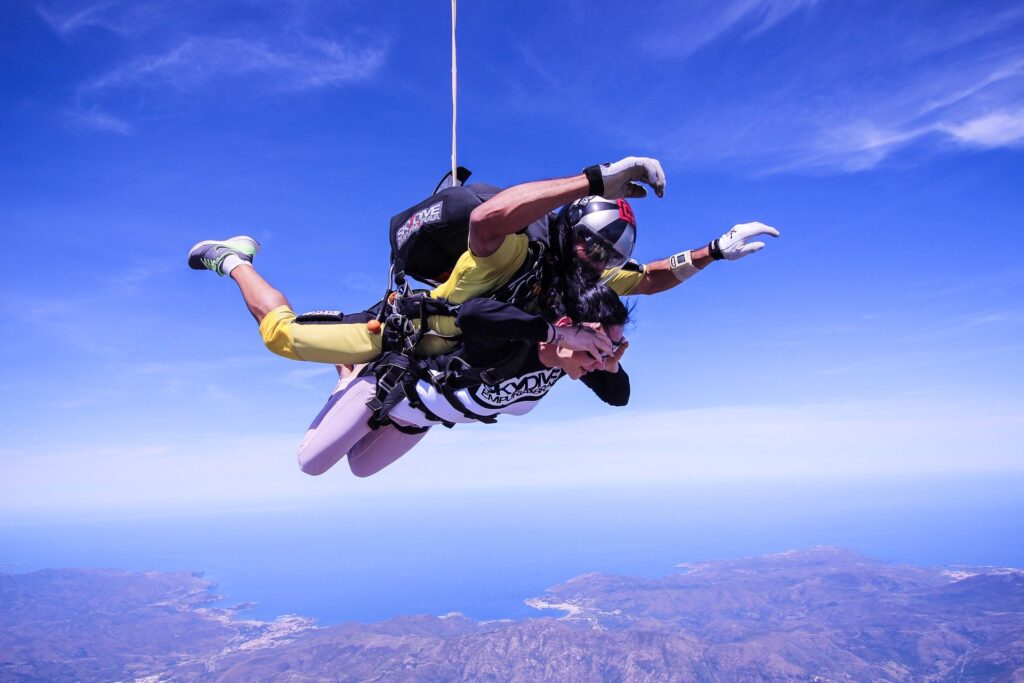Skydiving

I believe there’s no other sport in the world that gives you the feeling of flying like skydiving (maybe just base jump …) and it’s certainly the most adrenaline-pumping of the three, considering hang gliding and paragliding.
However, that feeling of being suspended in the air and feeling the adrenaline rushing through the veins are unique sensations.
HOW IT WORKS
The launch with the parachute is from an aircraft from about 4,000 meters above sea level and, after a short free fall, you open the wing at a certain altitude to cushion the landing. The beauty of skydiving is the free fall. That minute when you are free from everything and fly.
To jump alone you need to take a course, but those who just want to try can do a tandem jump.
After the briefing and the preparation of the harness, you get on the aircraft that will take you to the right altitude.
Arriving at the launch point, the instructor hooks your harness to his, you sit together at the base of the aircraft with your legs out of the door and, at the moment of launch, the instructor will give a push to jump off.
At that point you are flying. Maintain the position, look up and above all do not open your mouth! 😉
In that minute, minute and a half, of free fall (yes, it lasts so little unfortunately), based on your confidence with the air and with the situation, your instructor may decide to do some evolution with you, some rotation (always with very controlled movement) before opening the glider.
At that moment you will no longer be in a horizontal but vertical position, as on a paraglider and the landing phase begins. The parachute glider is operated in a similar way to a paraglider, through handles connected to the glider via ropes.
A few steps on the ground and soon you will be ready to start again, just a few minutes to work off the adrenaline rush that has accompanied you all along.
By the way: it’s not possible to do practive thise sports individually, without having taken a course and having a license, but you can do it any time with an instructor.
WHEN and WHERE to GO
Skydiving is a sport that can be practiced all year round, based on the climatic conditions and air currents present on the site on the scheduled day of the flight or launch.
Skydiving requires that the territory be flyable by an aircraft from which to launch.
I advise you to jump where you can admire the view, even if you will be concentrated on your jump …
Alternatively, you can try flying in the wind tunnels.
ADRENALINE/7R
100%
is the minimum amount of DRD4-7R adventure gene that we think you should have to do this activity.
Take the test to find out how much% of 7R you have in your DNA.
DOCUMENTS AND REQUIREMENTS
In order to perform a tandem jump with the parachute, no particular physical skills are required, only the possibility of a short jog and a general good state of health.
There is no minimum age (for children, written permission from parents is required).
During the flight you don’t suffer from vertigo because you don’t use the sense of balance; having no optical reference that connects us with the ground, there is no sense of depth, therefore it is impossible to feel dizzy in the air.
A few little tips:
- do not fly on an empty stomach; a light and dry breakfast helps not to feel any nausea in case you suffer slightly from seasickness, a chewing gum helps the most sensitive.
- if you fly in the afternoon have a light lunch
- arrive rested, a flight after a night of partying is not the ideal condition to face this beautiful adventure (besides the fact that no serious instructor will fly you if you are under the influence of alcohol or drugs, even if light)
- Carry out the experiences in this order: first a hang-glider flight, then a paraglider and then skydive; the adrenaline effect will increase 😉
RECOMMENDED CLOTHING and EQUIPMENT
To perform a skydive jump, the instructor will provide you with:
- Helmet: although not a risky activity, if practiced with responsibility and attention, the helmet is a fundamental precaution
- Sail: the heart of the parachute can be of various materials and sizes depending on the intended use of it.
- Harnesses: the harness allows you to secure the instructor and the passenger to the glider, thanks to belts and hooks.
- Emergency parachute: to cope with unforeseen events that, although very rare, could happen.
We recommend that you wear comfortable clothes and cover yourself a little more than in the season because there is more air up there and the temperature is lower. Some centers provide a suit to wear over your underwear.
We also recommend sports shoes.
We also recommend hiking shoes, possibly with a high ankle to facilitate the friction at take-off and landing and better protect the ankles.





